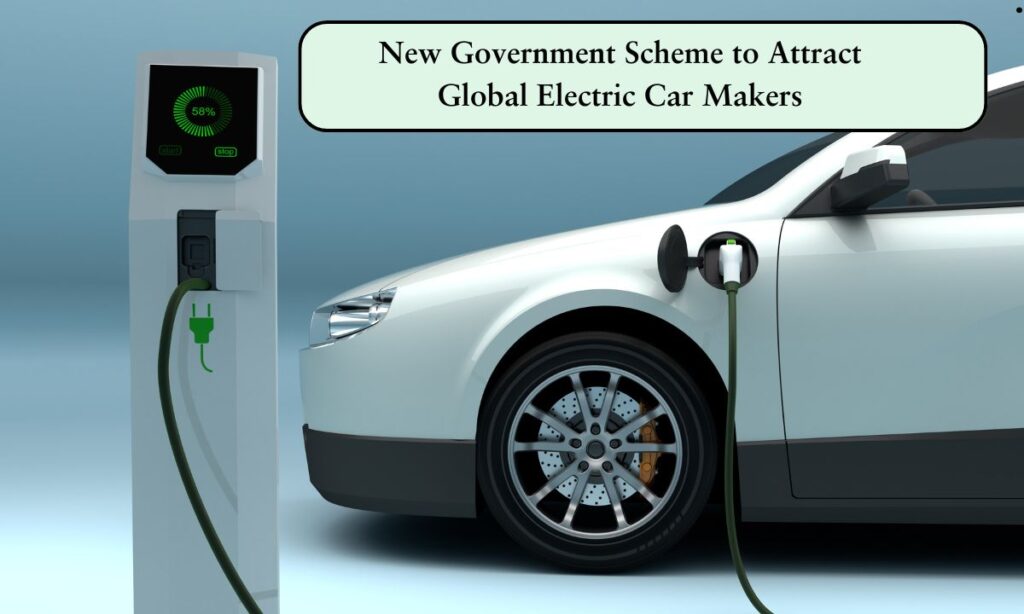New Government Scheme to Attract Global Electric Car Makers : India is fast-tracking its journey toward electric mobility. In a landmark move, the Ministry of Heavy Industries has officially rolled out detailed guidelines under its “Scheme to Promote Manufacturing of Electric Passenger Cars in India” (SPMEPCI).
Originally announced on March 15, 2024, the initiative is now fully operational, aiming to attract both domestic and international players to invest in electric vehicle (EV) manufacturing within the country.
If you’re a stakeholder, investor, or just an EV enthusiast, here’s everything you need to know — explained simply, with added context and examples.

🚘 What’s the SPMEPCI Scheme All About?
At its core, the scheme is India’s invitation to global EV manufacturers — think Tesla, BYD, or even Hyundai — to set up shop in India. The government is offering substantial benefits, such as reduced customs duties and a clear policy framework, in exchange for investments in domestic manufacturing.
Let’s break it down into key highlights and why they matter.
🔑 10 Major Highlights of the EV Manufacturing Scheme
1. Lower Import Duties for Premium EVs
Approved companies can import fully built electric four-wheelers (CBUs) priced at $35,000 or above at a reduced 15% customs duty for five years. This is a big drop from the standard 70–100%, making it much easier for luxury EV makers to enter the Indian market temporarily while setting up local facilities.
Example: A brand like Lucid Motors could introduce its premium EVs to Indian consumers while preparing to manufacture locally.
2. $500 Million Investment Requirement
Companies must commit to investing at least ₹4,150 crore (~$500 million) within three years. This ensures serious long-term commitment from applicants and avoids short-term opportunism.
Pro Tip: For startups exploring this space, forming joint ventures with established OEMs could be a smart route in.
3. Made-in-India Focus: Localization Targets
To boost local production and reduce import dependency:
- Minimum 25% domestic value addition (DVA) in 3 years.
- At least 50% DVA within 5 years.
This aligns with India’s ‘Make in India’ push and is measured using the PLI Auto Scheme criteria.
4. Only Large Players Need Apply
The eligibility bar is set high:
- Minimum ₹10,000 crore in global automotive revenue
- At least ₹3,000 crore in fixed assets
This effectively targets global giants and large Indian manufacturers — leaving small firms or new players to look for collaborations.
5. Import Limit with Duty Cap
Each approved company can import up to 8,000 EVs annually at the reduced rate. Unused quotas can roll over to the next year.
But there’s a cap: the total duty benefit is limited to ₹6,484 crore or the actual investment, whichever is lower. This balances government spending with company contributions.
6. Bank Guarantee for Financial Assurance
Applicants must provide a bank guarantee equal to:
- ₹4,150 crore, or
- The total customs duty exemption they claim —
whichever is higher.
This acts as a financial safeguard, ensuring companies follow through on their commitments.
7. Only Productive Investment Counts
Qualifying expenses include:
- New plant and machinery
- Research and development
- Up to 10% for buildings
- Up to 5% for EV charging infrastructure
Note: Land purchase costs do not count toward the investment.
8. Application Window: What to Expect
Applications will open once the Notice Inviting Applications (NIA) is published — expected soon.
- The first window will stay open for at least 120 days
- Re-openings may occur until March 15, 2026
Keep an eye on official channels if your company is considering applying.
9. Tied to Global Trade Developments
India’s trade talks with the UK, US, and EU are already shifting EV duty structures. For instance:
- India-UK Free Trade Agreement is reducing premium EV duties to 10%
- Future deals may further ease market entry barriers for Western automakers
This interconnectedness gives foreign brands multiple incentive layers to manufacture locally.
10. India’s Long-Term Vision: Net Zero & Jobs
The scheme isn’t just about cars — it’s about climate goals and economic growth.
- Supports India’s Net-Zero 2070 pledge
- Aims to generate employment
- Drives tech transfer and innovation
As EV adoption grows, India could become a global hub for green mobility manufacturing — much like China is today.
💡 Additional Insights to Maximize Value
🌍 Why This Matters for Global Companies
India offers:
- A massive consumer base
- Growing charging infrastructure
- A government actively investing in sustainable mobility
Entering India now could give first-movers a long-term edge
💼 Opportunities for Local Suppliers
Tier-1 and Tier-2 component manufacturers can benefit immensely from increased demand for:
- Lithium-ion batteries
- Electric drivetrains
- Power electronics
- Charging stations and management software
Startups in EV tech should explore B2B partnerships with approved OEMs.
📈 Boosting the EV Ecosystem
This scheme complements other government initiatives like:
- FAME II subsidies for EV buyers
- State-level policies offering land and tax incentives
- PLI schemes for advanced battery chemistry
Together, these make India one of the most attractive markets for EV expansion in the next decade.
✅ Key Takeaways
- India’s SPMEPCI scheme offers lower duties, investment incentives, and a clear roadmap for EV manufacturers.
- The program favors large, committed players willing to localize and invest.
- It supports India’s broader ambitions in sustainability, job creation, and industrial leadership.
If you’re in the EV sector — as a manufacturer, investor, or startup — now is the time to engage with this opportunity.
🙋♂️ FAQs
Q1. Can smaller startups benefit from this scheme?
Not directly, but they can partner with approved large players or position themselves as local suppliers or service providers.
Q2. What happens if a company fails to meet the investment or localization targets?
They risk losing their customs duty benefits and may forfeit their bank guarantee — a significant financial penalty.
Q3. Is this the same as the FAME II scheme?
No. FAME II focuses on consumer subsidies for EV buyers. SPMEPCI targets manufacturers and investors in EV production.